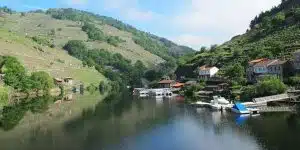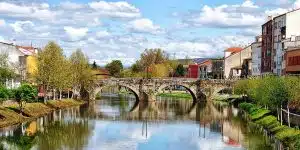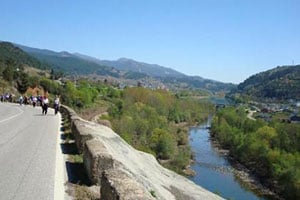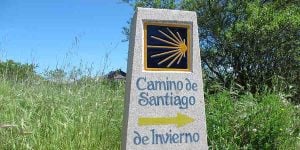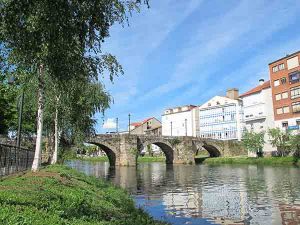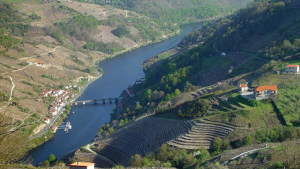Camino de Invierno
The Camino de Invierno, or Winter Way, is one of the most beautiful and lesser-known Camino de Santiago routes. Traditionally, pilgrims took this route during the colder months to avoid the snow-covered mountains of O Cebreiro on the Camino Francés. Today, it offers a peaceful, off-the-beaten-track alternative, perfect for walkers seeking stunning scenery, rich culture, and fewer crowds.
The last 100 km of the Camino de Invierno take pilgrims from Monforte de Lemos, the capital of the Ribeira Sacra wine region, to Santiago de Compostela. This is a journey through vineyard-covered valleys, river canyons, and Roman bridges, in a landscape that feels timeless and deeply spiritual. The Ribeira Sacra, whose name means “Sacred Riverside,” is renowned for its terraced vineyards, Romanesque monasteries, and ancient winemaking traditions dating back to the Romans.
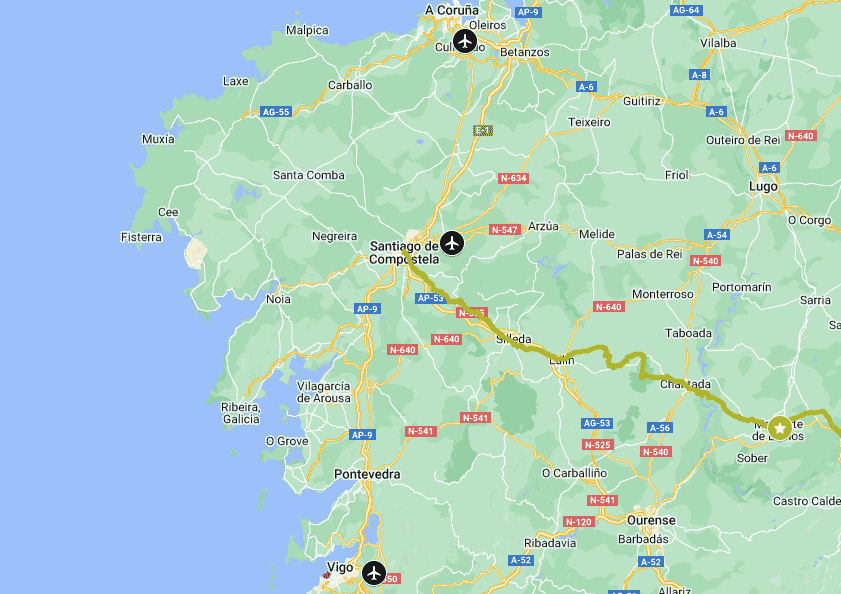
One of the route’s highlights is the village of Belesar, where pilgrims cross a Roman road overlooking the River Miño and its spectacular canyons. With each step, the trail reveals the natural beauty and heritage of Galicia — from quiet hamlets and medieval churches to sweeping mountain views.
Although known as the “Winter Way,” the Camino de Invierno is best enjoyed in spring or autumn, when the weather is mild, and the vineyards glow in vibrant colour. Completing the final 100 km of this route allows pilgrims to earn their Compostela certificate at Santiago’s Pilgrim Office, just as on other official Caminos.
For those who appreciate history, tranquillity, and challenge, the Camino de Invierno offers a rewarding pilgrimage through one of Spain’s most enchanting regions — a secret Camino waiting to be discovered.
Why Walk the Camino de Invierno?
- A secret Camino with fewer crowds.
- Cross the Ribeira Sacra, Galicia’s wine-making heart.
- Explore Europe’s largest collection of Romanesque churches.
- Walk along ancient Roman roads through villages like Belesar.
- Earn your Compostela while enjoying a route rich in legends and nature.
Suggested Routes
Highlights of the Camino de Invierno
- Monforte de Lemos, the heart of Ribeira Sacra wine country.
- The Roman village of Belesar, overlooking the River Miño.
- Peaceful terraced vineyards and chestnut forests.
- Romanesque chapels and monasteries along the way.
- The final arrival into Santiago de Compostela.
Suggested Routes
- Camino de Invierno – Monforte to Santiago (138 km, 7 nights).
- Custom sections available to match your timeframe and fitness level.
👉 Not sure if this route is for you? See our Camino Fitness Plan.
When to Go
Traditionally used in winter, the Camino de Invierno is now best enjoyed in spring or autumn, when the landscapes are at their most beautiful.
- Spring → vineyards in bloom, mild weather.
- Autumn → grape harvest, golden colours in Ribeira Sacra.
- Winter → quiet, but weather can be harsh.
- Summer → warm and dry, though less shaded than other routes.
👉 Compare with our Best Time to Walk the Camino.
Terrain & Difficulty
The Camino de Invierno is a moderately challenging route, with hills, river valleys, and sections on old Roman roads. It is well-marked but best suited for walkers with some experience.
👉 Prepare with our Camino Fitness Guide.
What to Bring
- Comfortable hiking shoes for mixed terrain.
- Clothing layers for changing mountain weather.
- A reusable water bottle and sun protection.
👉 Download our free Camino Packing List.
Camino Ways Route Planner
For over 1000 years, pilgrims from all over the world have walked the Camino Ways across Europe in their quest for spirituality. Making the pilgrimage to Santiago de Compostela in Spain, they encountered a variety of people, cultures and beliefs, leading to friendship and new experiences. This continues today with the Camino de Santiago being the most well known and well-loved walk in the world. More than just a walk, the Camino de Santiago is an unforgettable and unique journey for the body, mind and soul.
History of the Camino de Invierno
The Winter Way is steeped in history. Pilgrims once used it to bypass the snow-bound mountains of O Cebreiro. The Ribeira Sacra region itself is rich in heritage, with centuries-old monasteries and over 100 Romanesque buildings still standing.
The Romans introduced viticulture here, creating the terraced vineyards still used today. Belesar preserves stretches of the original Roman road, reminding pilgrims of the Camino’s deep past.
👉 Read about the History of the Camino.
FAQs – Camino de Invierno
Q: What is the Camino de Invierno?
A: A historic Camino route from Monforte de Lemos to Santiago, once used to avoid the snowy O Cebreiro pass.
Q: How long is the Camino de Invierno?
A: The last 100 km from Monforte to Santiago takes about 7 days to walk.
Q: Do I get a Compostela?
A: Yes. Completing the last 100 km on foot qualifies you for the Compostela certificate.
Q: When is the best time to walk it?
A: Spring and autumn for the best landscapes. Winter is possible but more challenging.
Q: Is it suitable for beginners?
A: It’s moderately challenging. Check our Camino Fitness Plan before deciding.
Closing Thought
The Camino de Invierno is one of the Camino’s best-kept secrets: peaceful, steeped in history, and full of natural beauty. For pilgrims seeking a quieter but equally rewarding way to Santiago, this is a journey of discovery through Galicia’s hidden heart.
👉 Ready to try the Winter Way? Plan your trip with our Camino Planner.
